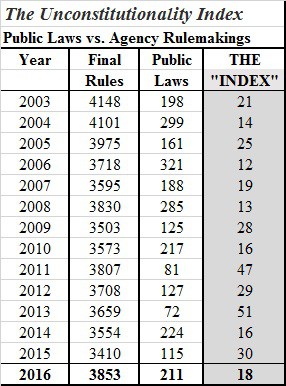The 2017 Unconstitutionality Index: 18 Federal Rules for Every Law Congress Passes

 Outgoing president Barack Obama, who maintained a website devoted to the refrain “We Can’t Wait,” loved taunting opponents with the “pen and phone” unilateral executive actions that became his legacy.
Outgoing president Barack Obama, who maintained a website devoted to the refrain “We Can’t Wait,” loved taunting opponents with the “pen and phone” unilateral executive actions that became his legacy.
We’ll see what happens after Donald Trump takes the oath of office, having promised to freeze federal regulation and to aggressively eliminate rules.
There are no guarantees of smaller government, however. The Republican Party as constituted before November 8th accommodated President Obama, and would not block excessive regulatory actions or executive overreach via the constitutional means at its disposal—withholding the purse. They were too worried about being blamed for shutting down the government.
The incoming 115th Congress will in all likelihood roll back some Obama rules issued during the final stretch of his term, using “resolutions of disapproval” allowed by the Congressional Review Act (CRA).
That effort could potentially get rid of many dozens of rules, but, knowing Republicans, will probably get rid of just a few. Even maxed out, CRA “resolutions of disapproval” will be only a start of what’s needed in 2017.
Bolder 100-Minute and 100-Day Agendas are needed because hundreds of federal agencies issue thousands of rules and regulations annually, a pace that far outstrips the number of laws enacted by Congress each year.
Let’s look at it. In 2016, Congress passed “only” 211 Public Laws, per this preliminary tally I’ve derived from the Government Publishing Office’s archive of Public Laws through November 28th, plus Obama’s signed legislation outlined on the White House website since then.
Such annual tallies include legislative initiatives ranging from naming post offices after politicians and dignitaries, to major reworkings like Obamacare.
In 2016, things started with January’s “Child Nicotine Poisoning Prevention Act,” through the “No Veterans Crisis Line Call Should Go Unanswered Act” on November 28th, at which point there were 132 public law listed and is where to GPO count stands today. To this we add a preliminary count of 79 laws Obama signed since November 28th that have not yet made it to the GPO site. There may be a few more to come, but not much. So the 2016 preliminary total is 211.
The federal bureaucracy was far busier making laws than Congress, however.
By December 30th, the last workday of the year, in a record-setting Federal Register of 97,110 pages, agencies had issued 3,853 rules and regulations, 43 more than last year. (This count is the preliminary tally from the National Archives’ Federal Register database; a final tally a tad higher or lower will be issued within a couple months.) This count is 443 above last year’s tally.
Now, any given year’s regulations are not likely to be tied to the laws enacted that same year. Nonetheless, in terms of raw flow, federal agencies in 2016 issued 18 rules and regulations for every law Congress passed.
I like to call that multiple The Unconstitutionality Index; the multiple of unelected agency rules, over the number of laws from our elected Congress.
The nearby chart depicts the Index going back to 2003 (you can go back earlier in the Ten Thousand Commandments roundup (in Historical Tables, Part J).
There’s no pattern to any of this, since the numerators and denominators can vary widely; there had been 114 laws in 2015, and a multiple of 39. The multiple can be higher with fewer laws, or with more regulations, holding the other constant. The point is that agencies do the bulk of lawmaking, no matter the party in power.
The multiple did tend to be higher during Obama Administration. Bush’s eight years averaged 20, while Obama’s almost-eight have averaged 29.

Legislators of both parties relinquished their constitutional authority and tolerate the Administrative State. Yet lawmaking without the involvement of elected representatives goes well beyond what this “Index” captures.
The notice-and-comment process for rules built into the Administrative Procedure Act is eroded further by regulatory dark matter like guidance documents, memoranda, notices, letters, and other proclamations that are now prominent means of agency action. Sometimes such proclamations get buried among over “notices” published in the Federal Register every year, of which there are 24,557 in 2016. But much sub-regulatory guidance does not even get published in the Register.
It’s up to the 115th Congress to develop a regulatory liberalization agenda with the new president, since regulators and bureaucrats have unleashed pens and phones of their own.
Happy 2017.